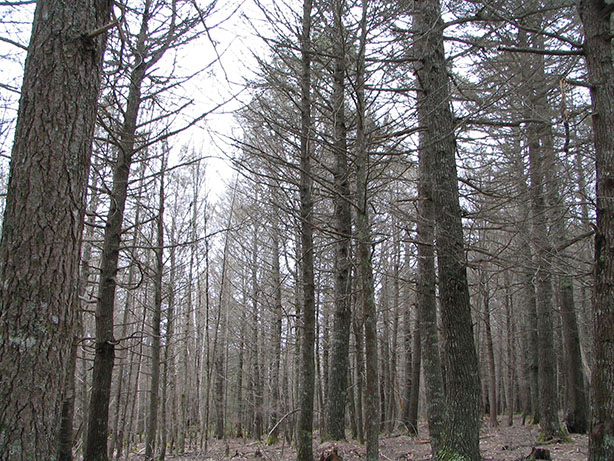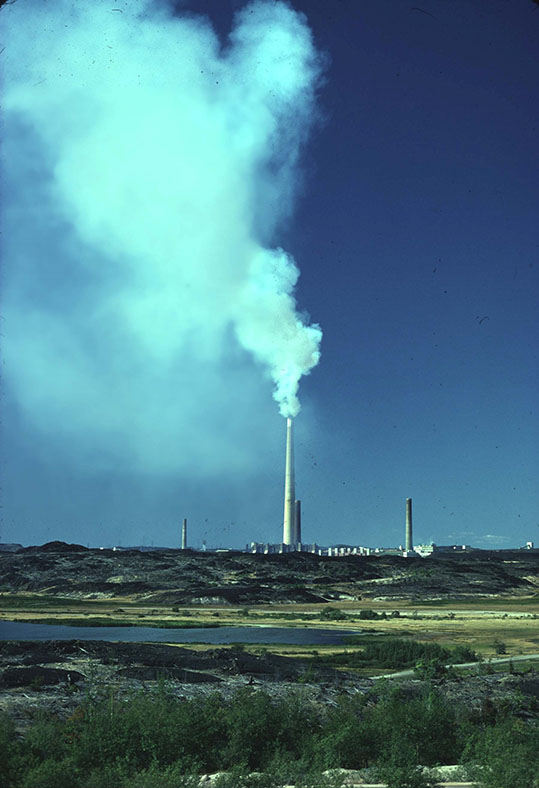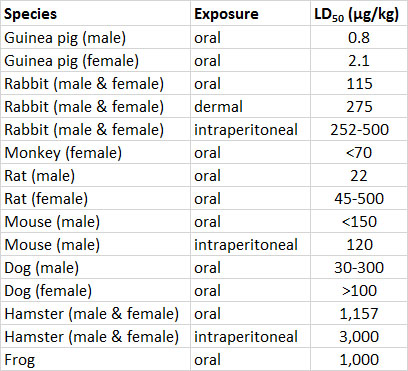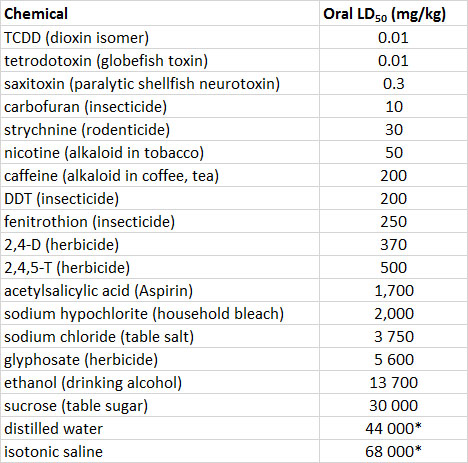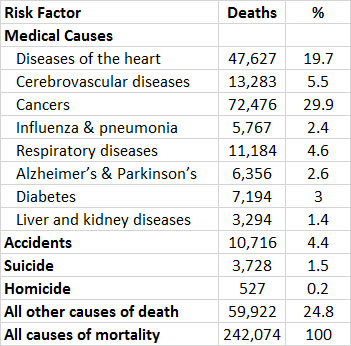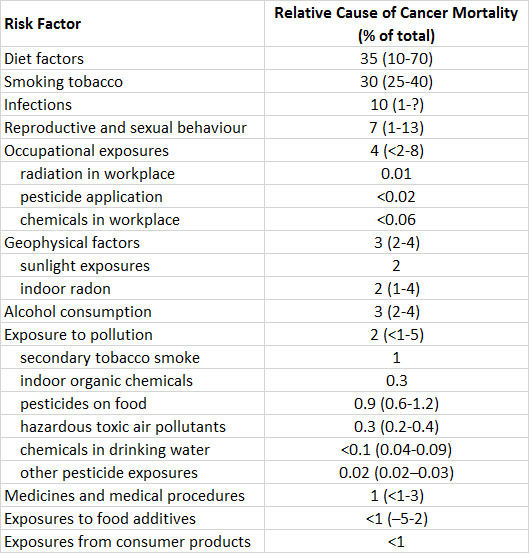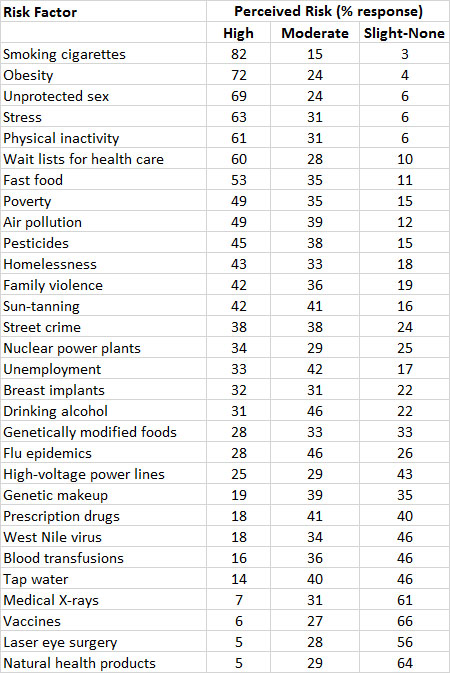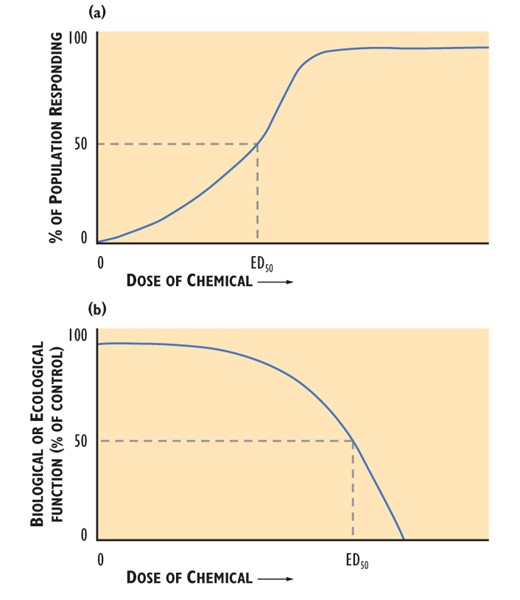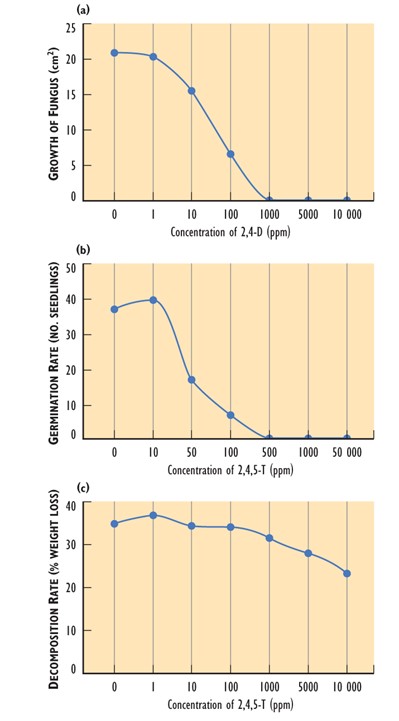Chapter 15 ~ Environmental Stressors
Key Concepts
After completing this chapter, you will be able to
- Describe the environmental stressors, their causes, and how ecosystems respond to changes in their intensity.
- Explain the differences between contamination and pollution.
- Provide examples of natural stressors and explain how knowledge of them can help us understand anthropogenic stressors.
- Outline the differences among toxicology, environmental toxicology, and ecotoxicology.
- Explain the differences between voluntary and involuntary risks.
- Identify how a risk assessment is done of a predicted exposure to a toxic chemical.
Environmental Stressors
Environmental stressors (stressors) are factors whose influence is to constrain productivity, reproductive success, and ecosystem development (see Chapter 9). To some degree, stressors affect all organisms as well as their populations, communities, and ecoscapes (landscapes and seascapes). Stressors may be natural in origin, being associated with such environmental influences as:
- competition, predation, disease, and other interactions among organisms
- constraints related to climate or to inadequate or excessive nutrients, moisture, or space
- disturbances such as wildfire and windstorms
The effects of natural stressors are not always negative. Some individuals, populations, and communities may benefit from the effects of natural stress, even while others suffer a degree of damage.
Increasingly, however, stressors associated with human activities are the most critical influence on species and ecosystems. In too many cases, anthropogenic stressors are causing important damage to resources that are needed to sustain people and their economy, and also to natural biodiversity and ecosystems.
Image 15.1. Wildfire, windstorms, and insect outbreaks can be extensive disturbances that affect ecosystems at a landscape scale. This photo shows a stand of eastern hemlock (Tsuga canadensis) trees that has been killed by several years of defoliation by a native moth (Iridopsis ephyraria) in Nova Scotia. Source: B. Freedman.
Environmental stressors may occur as an intense, short-lived event of destruction, also known as a disturbance. Alternatively, stressors may exert their influence over an extended period of time – that is, in a chronic manner. The interaction of organisms with a stressor at a particular place and time is called exposure. Exposure can be instantaneous or it may accumulate over time. If an exposure is intense enough, it will cause some sort of biological or ecological change, called a response, to occur. It is important to understand, however, that individuals, populations, and communities are capable of tolerating a range of intensity of stressors without suffering significant damage. In other words, certain thresholds of biological or ecological tolerance must be exceeded before damage is caused (Image 15.2).
Image 15.2. Stressors are environmental factors that affect organisms and ecosystems. They may exist at varying intensities of exposure, as is suggested by the metaphor of a water faucet, whose dial if turned to the right will increase the flow of water, or decrease or stop it if turned the other way. For actual stressors, if a threshold of biological or ecological tolerance is exceeded, then a response will occur. Source: B. Freedman.
Damage occurs when one or more stressors elicit responses that can be interpreted as a degradation of environmental quality. Such responses may include illness or death caused by an exposure of wild animals to pesticides, or as a reduction of the productivity of ecosystems, or the endangerment of vulnerable elements of biodiversity. In this chapter, we examine a conceptual framework for the study of damage caused by stressors. In the following 11 chapters, we deal with specific kinds of stressors and examine case studies of the kind of damage they may cause to occur.
Kinds of Stressors
The diverse kinds of environmental stressors are grouped into classes, although they are not entirely exclusive.
- Physical stress is a disturbance in which there is an intense exposure to kinetic energy, which causes damage to habitats and ecosystems. Examples include such disruptive events as a hurricane or tornado, a seismic sea wave (tsunami), the blast of a volcanic eruption, an explosion, or trampling by heavy machinery or hikers.
- Wildfire is another disturbance, which involves the uncontrolled combustion of the biomass of an ecosystem. A wildfire can be ignited by people, or naturally by lightning. A severe fire consumes much of the biomass of an ecosystem, but even a less-severe wildfire may kill many organisms by scorching and poisoning by toxic gases.
- Chemical pollution occurs when one or more substances occur in a concentration high enough to elicit physiological responses in organisms, potentially causing toxicity and ecological change. Chemical stressors include pesticides, gases such as ozone and sulphur dioxide, and toxic elements such as arsenic and mercury. Pollution may also be caused by excessive nutrients, which can distort productivity and other ecological functions. Note that the mere presence of a potentially toxic agent does not necessarily cause pollution. (The distinction between contamination and pollution is examined later in this chapter.)
- Thermal pollution is caused by the release of heat (thermal energy) into the environment, which results in ecological stress because species vary in their tolerance of temperature extremes. Thermal stress may occur at natural springs and submarine vents where geologically heated water is emitted. It is also associated with discharges of hot water from power plants.
- Radiation stress is caused by excessive exposure to ionizing energy. The radiation may be emitted by nuclear waste or explosions, or it can be diagnostic X-rays or solar ultraviolet energy.
- Climatic stress is associated with insufficient or excessive regimes of temperature, moisture, solar radiation, wind, or combinations of these.
- Biological stressors are associated with interactions occurring among organisms, such as competition, herbivory, predation, parasitism, and disease. For example, individuals of the same or different species may compete for essential resources that are limited in supply. Herbivory, predation, parasitism, and disease are trophic interactions, in which one species exploits another. Exploitation can be anthropogenic, as when humans harvest wild animals or trees, or it can be natural, perhaps associated with defoliating insects or disease-causing pathogens.
- Biological pollution occurs when people release organisms beyond their natural range. This might involve the introduction of alien species that invade and alter natural habitats, or it may be the release of pathogens into the environment through discharges of raw sewage.
Image 15.3. Biological “pollution” is caused when species are introduced into habitats beyond their natural range, where they may cause ecological damage. This non-native lupine (Lupinus polyphyllus) has been introduced to eastern Canada, where it thrives in gardens and along roadsides. Although an attractive wildflower, it displaces indigenous plants. Source: B. Freedman.
Ecological Responses
An ecosystem that has been affected by a disturbance typically suffers mortality among its species, along with damage to its structural properties (such as species composition and biomass distribution) and functional attributes (such as productivity and nutrient cycling). Once the disturbance event is over, a process of recovery through succession begins. If the succession proceeds for a long enough time, it will restore another mature ecosystem, perhaps one similar to that existing before the disturbance.
Chronic stressors operate over longer periods of time (rather than as events), and they include climatic factors and many kinds of chemical and thermal pollution. Depending on the intensity of exposure, organisms may suffer acute toxicity resulting in tissue damage or even death, or a less-obvious chronic damage that results in decreased productivity.
Exposure to a higher intensity of environmental stressors can result in evolutionary changes if individual organisms vary in their tolerance and those differences are genetically based. Under such conditions, natural selection in favour of tolerant individuals will eventually result in increased tolerance at the population level. At the community level, relatively vulnerable species will be reduced or eliminated from the habitat if the intensity of stress increases markedly. The niches of those species may then be occupied by more tolerant members of the community, or by invading species that are capable of exploiting a stressful but weakly competitive habitat.
A prolonged intensification of stress will cause longer-term ecological change to occur. Consider, for example, a case in which a new metal smelter is constructed in a forested landscape. If the smelter emits toxic sulphur dioxide gas, the toxic stress will damage the tree-sized plants of the forest and eventually cause them to give way to shrub-sized and herbaceous vegetation. If the long-term stress is extremely severe, the landscape could entirely lose its vegetation. This kind of damage has actually occurred around a number of Canadian smelters, such as those near Sudbury (Chapter 16).
This kind of ecological damage involve changes in the composition and dominance of species in communities, in the spatial distribution of biomass, and in functions such as productivity, litter decomposition, and nutrient cycling. Because a smelter is a discrete point source of environmental stress, the ecological responses eventually stabilize as gradients of community change that radiate outward, in a downwind or downstream direction from the source of pollution.
The intensity of a stressor may also decrease in time and space. When this happens, the ecological responses are, in many respects, the reverse of the damage that occurs when the stress intensifies. These changes represent a process of recovery through succession. In the case of the Sudbury smelters, emissions of pollutants have decreased greatly because of the installation of pollution-control technologies. This has resulted in much less toxic stress in the surrounding environment, which has allowed some ecological recovery to occur (Chapters 16 and 18).
Ecologists have described the general attributes of ecosystems that have been subjected to severe stress for a period of time. In general, as environmental stress intensifies significantly (such as by increasing pollution), the following changes are observed:
- mortality increases, especially of the most vulnerable species
- species richness decreases
- the stocks of nutrients and biomass become depleted
- the rate of community respiration exceeds that of production, so the net production becomes negative.
- sensitive species are replaced by more-tolerant ones
- top predators and large-bodied species may be lost from the ecosystem
- previously self-maintaining ecosystems may require active management to sustain their desirable attributes, for example, to maintain declining populations of rare or economically valuable species that have become threatened
Ecosystems that are chronically exposed to intense stress (such as climate-stressed tundra) eventually stabilize. Typically, the stable ecosystems are low in species richness, simple in structure and function, and dominated by relatively small, long-lived species. As well, they have low rates of productivity, decomposition, and nutrient cycling.
If an increase in environmental stress has an anthropogenic causation, then the resulting ecological changes are often considered to represent damage and are viewed as a degradation of environmental quality and ecological integrity (these terms are examined in Chapter 27).
Image 15.4. Natural disturbances such as wildfire initiate a process of ecological recovery known as succession. This photo shows a burned area of boreal forest near Inuvik in the Northwest Territories. The community at this early stage of succession is dominated by an herbaceous plant called fireweed (Epilobium angustifolium). Source: B. Freedman.
Contamination and Pollution
Pollution is caused by an exposure to chemicals or energy at an intensity that exceeds the tolerance of organisms. As such, pollution is judged to have occurred when it can be shown that organisms have suffered toxicity, or other kinds of ecological damage can be demonstrated. Pollution can affect humans and other species, as well as communities and ecoscapes. Pollution is often caused by an exposure to chemicals in large enough concentrations to poison at least some organisms. However, pollution can also be caused by non-toxic exposures, such as the excessive fertilization of a waterbody, a release of waste heat into the environment, or the discharge of raw sewage containing pathogens.
Contamination refers to those much more common situations in which potentially damaging stressors are present in the environment, but at an intensity too low to cause measureable damage. For instance, a certain chemical may occur in a higher concentration than is normally encountered in the environment. However, if its concentration is too low to cause measurable toxicity to at least some organisms, or to affect other ecological components or processes, the chemical is a contaminant rather than a pollutant.
In fact, metals such as aluminum, cadmium, lead, mercury, and zinc are present in all parts of the environment, including all organisms, in at least a trace concentration. If the detection limits of the available analytical chemistry are sensitive enough, this “universal contamination” by metals can easily be demonstrated. Although all metals (and any other chemicals) are potentially toxic, they must be present in a high enough concentration for a long enough period of time to actually poison organisms and cause ecological damage. In other words, the exposure must exceed biological tolerances before damage is caused and pollution can be said to occur.
Pollution and contamination are often judged with a human-focused bias. People decide whether pollution is causing “damage” at some place and time, and how important the effects might be. This anthropocentric bias tends, quite naturally, to favour humans and those species, communities, and ecosystem functions that are recognized as supporting the human economy, or may be appreciated for other reasons, such as aesthetics.
Interestingly, certain species, communities, and ecological processes will actually benefit from most kinds of pollution. For example, particular species may take advantage of ecological opportunities made available when pollution reduces the abundance of a previously dominant species. Many of the case studies described in following chapters involve situations in which opportunistic species of plants, animals, and microorganisms have benefited from ecological changes caused by pollution.
Pollution Can Be Natural
Pollution is not only caused by human activities – in some cases, it is a purely natural phenomenon. “Natural” sources of pollution include emissions of particulates and gases such as sulphur dioxide from volcanoes, seeps of petroleum on the ocean floor, high concentrations of metals in certain soils and rocks, and the heat of geothermal springs. Natural pollution may cause severe ecological changes (which humans may view as being a kind of damage). The effects can be as intense as those caused by anthropogenic pollution. Nevertheless, although the fact of natural pollution is interesting and well recognized, it does not justify human activities that cause similar kinds of damage.
Studies of the ecological effects of natural pollution can provide insight into the potential longer-term effects of anthropogenic emissions. This is because many examples of natural pollution are ancient, and the resulting patterns of ecological change may be similar to those caused by more recent anthropogenic emissions.
One interesting example occurs at the Smoking Hills in the Northwest Territories. This is a remote wilderness, and is little influenced by people. At several places along the seacoast and nearby rivers, erosion has exposed deposits of bituminous shale. These carbon-rich deposits have spontaneously ignited at various places and have been smouldering for centuries and fumigating the nearby tundra with sulphur dioxide. The SO2 is toxic to plants and also causes soil and water to become highly acidic. The natural pollution has severely damaged terrestrial and aquatic habitats of the tundra at the Smoking Hills (see Chapter 16).
Another example of natural pollution occurs when metal-rich minerals occur close to the surface of the ground, which results in toxic conditions for vegetation. For example, plant ecologists have studied soil containing “serpentine” minerals, which are rich in nickel and cobalt. When they occur in high concentrations, these metals are toxic to most plants. Habitats containing serpentine minerals develop a distinctive plant community that is dominated by low-growing species that can tolerate the toxic stress of the metal-rich soil (see Chapter 18).
An additional case of natural pollution involves certain species of marine phytoplankton that occasionally become abundant and cause ecological damage. In events called toxic blooms, these algae release biochemicals that are poisonous to a broad range of animals that are exposed through the food web. In some cases, humpback whales have died at sea after eating fish polluted with saxitoxin, a potent neurotoxin synthesized by dinoflagellate algae. The algal toxins are also a risk to people eating fish polluted by this and other chemicals, such as domoic acid.
Research and discussion of naturally occurring pollution is useful and informative in environmental science. However, in this book, we emphasize pollution caused by human activities and its resulting damage. This focus is sensible because anthropogenic pollution is increasing rapidly in many countries, including Canada. Consequently, there is a pressing need to avoid or manage the damage that pollution can have on people as well as natural ecosystems.
Anthropogenic Pollution
In the modern world, an enormous amount of pollution is associated with human activities. This has caused important damage to human health and to managed and natural ecosystems. People cause pollution in diverse ways, and we examine them in following chapters. Most commonly, anthropogenic pollution is associated with these kinds of activities:
- accidental or deliberate emissions of chemicals into the environment, such as sulphur dioxide, metals, pesticides, and petroleum
- releases of substances that react in the environment to synthesize chemicals of greater toxicity – this is known as secondary pollution (as occurs when ozone is created by photochemical reactions in the atmosphere)
- emissions of chemicals that degrade stratospheric ozone, such as chlorofluorocarbons
- releases of waste industrial heat, as when a power plant discharges hot water into a river or lake
- discharges of nutrient-laden sewage or fertilizer into waterbodies
- emissions of greenhouse gases that threaten global climate
- releases of alien species that cause damage when they invade managed or natural habitats, or are pathogens of people, crops, or native species
Image 15.5. Many human activities result in emissions of pollutants into the environment. This image shows a 380-m smokestack at a metal smelter near Sudbury, Ontario. Source: B. Freedman.
Disturbance
A disturbance is an episodic but intense disruption that causes severe biological and ecological damage. An event of disturbance is followed by a sometimes lengthy period of ecological recovery through the process known as succession. There are two broad types of disturbances: community-replacing disturbances and microdisturbances.
- A community-replacing disturbance is extensive in scale and results in a catastrophic destruction of one or more original communities. Natural examples are caused by wildfire, windstorm, avalanche, and glaciation, while anthropogenic ones include clear-cutting and ploughing. These large-scale disturbances may be followed by a successional recovery that eventually regenerates a community similar to what was destroyed. Younger communities in the successional sequence (or sere) are relatively dynamic in their structural and functional properties. They are typically dominated by species that are abundant only during the initial stages of recovery, when competition is not so intense. Community changes in later stages are somewhat less dynamic, until a late-stage community is re-established.
- A microdisturbance involves a local disruption that only affects a small area within an otherwise intact community. Anthropogenic microdisturbances include the selective harvesting of individual large trees or particular animals, while leaving the community otherwise intact. Ecological changes are relatively rapid within a habitat patch that has been affected by a recent microdisturbance, but at the stand level the community is stable. So-called patch- or gap-phase successional dynamics occur in all natural forests but are particularly important during the later stages of succession. This is especially the case in older-growth forest, where individual trees might die from disease, insect attack, or a lightning strike, creating a gap in an otherwise intact canopy.
Natural Disturbance
Disturbance is a natural force that affects all ecosystems. For example, a wildfire may kill mature trees over a large area, but that event of destruction is followed by regeneration through succession. Fire is common in the boreal forest and in drought-prone ecosystems such as prairie and savannah. On average, about 2-million hectares of forest burns each year in Canada, mostly in fires started by lightning. Wildfire transforms the habitat conditions and also causes severe pollution by the emission of particulates and gases such as carbon dioxide and nitrogen oxides to the atmosphere.
Other natural agents of disturbance include hurricanes, tornadoes, floods, and even glaciation (over geological time). These also cause large-scale ecological damage, which is followed by successional recovery. After glaciation, which involves prolonged burial and abrasion of the land by an enormous mass of ice, the post-melting recovery is initiated by immigrating organisms that colonize the raw landscape.
A volcanic eruption or earthquake can generate one or more devastating oceanic waves, or tsunamis. In 1883, the cataclysmic eruption of the volcanic island of Krakatau in Indonesia created a 30-m tsunami wave that killed about 36-thousand people. In 2004, more than 225-thousand people were killed by a tsunami in the Indian Ocean (see Global Focus 3.1). In 2011, a subsea earthquake generated a tsunami of up to 40.5 m that devastated coastal regions, travelled up to 10 km inland over low-lying terrain, caused at least 18-thousand deaths, destroyed hundreds of thousands of buildings, and created a technological crisis when flooding rendered inoperable the control systems of a large nuclear power plant.
The blast and heat of a volcanic eruption can also damage ecosystems, as occurred in 1980 when Mount St. Helens in Washington erupted in a more-or-less sideways blast. The explosion blew down 21-thousand ha of conifer forest, killed another 10-thousand ha by heat injury, and otherwise damaged an additional 30-thousand ha. There were also devastating mudslides, and a huge area was covered with particulate ejecta (known as tephra) that settled from the atmosphere 50-cm or more deep.
A volcanic eruption can also emit huge amounts of sulphur dioxide, particulates, and other pollutants high into the atmosphere. About 2-5 million tonnes of SO2 (expressed as the sulphur content, or SO2-S) are emitted by volcanoes in a typical year, and an individual eruption may emit more than 1-million tonnes. This natural SO2 contributes to the acidification of precipitation and to other environmental damage (Chapter 19).
Natural population outbreaks (irruptions) of herbivores, predators, or pathogens can also result in intense damage to natural habitats. For instance, the spruce budworm (Choristoneura fumiferana) periodically defoliates huge areas of conifer forest in eastern Canada (more than 55 million hectares in 1975). This causes extensive mortality of fir and spruce trees and other ecological damages (Chapter 22). A recent outbreak of the mountain pine-beetle (Dendroctonus ponderosae) has caused similarly extensive damage to pine forests in western Canada and the northwestern U.S., with about 36-million ha affected. A marine example is the green sea urchin (Strongylocentrotus droebachiensis), which occasionally irrupts in rocky subtidal habitats off Nova Scotia. These invertebrates can over-graze mature “forest” of the kelps Laminaria and Agarum, resulting in a “barren ground” with much less productivity and biomass. After the population of sea urchins collapses, the kelp forest quickly re-establishes.
Microdisturbances are also a common feature of natural ecosystems. Examples of these smaller-scale disturbances include the deaths of individual large trees within an otherwise intact forest, perhaps caused by disease or an accident (such as a lightning strike). This creates a natural gap in the canopy, beneath which a microsuccession occurs as plants compete to take advantage of temporary resource opportunities such as extra light. The foliage of mature trees eventually fills the gap. Similarly, the death of an individual coral head within an otherwise intact reef initiates a microsuccession within that marine ecosystem.
Ecologists try to understand the effects of natural disturbances and to apply that knowledge to design management systems that allow resources to be harvested or otherwise used while controlling the resulting ecological damage. For example, understanding the characteristics of gap-phase disturbances in an old-growth forest can aid in the design of a selective harvesting system that emulates the natural disturbance regime. The use of that kind of system will leave the physical and ecological integrity of the forest substantially intact, even while individual trees are periodically harvested for commercial use. Those individuals would be replaced by natural regeneration. In view of the natural, gap-phase disturbance dynamics of old-growth forest, clear-cutting followed by the planting of tree seedlings might be considered a less “natural” management system. However, clear-cutting might be an appropriate practice to use when harvesting forest that is adapted to community-replacing disturbances, such as wildfire or insect outbreaks (see Chapters 22 and 23).
Anthropogenic Disturbance
Humans also disturb ecosystems in diverse ways, many examples of which are described in the following chapters. Anthropogenic disturbances are associated with many activities, such as the conversion of ecosystems, the harvesting of natural resources, introductions of alien species, construction of roads and buildings, and warfare.
The harvesting of both renewable and non-renewable resources always causes disturbances to ecosystems. So does the post-harvest management of renewable resources. For instance, intense disturbance is caused by strip-mining the surface for coal or oil-sand. Similarly, harvesting a forest by clear-cutting represents a community-replacing disturbance, which is followed by regeneration through succession. Additional disturbances may be associated with silvicultural management, such as scarification to prepare the land for planting tree seedlings, and herbicide spraying to decrease the abundance of weeds. Harvesting may also be selective, as when particular species or sizes of trees or fish are targeted for harvesting. This may represent a kind of gap-phase disturbance.
The conversion of natural ecosystems into agricultural or urbanized land-uses also represents a severe disturbance. In these cases, the successional recovery is closely managed to foster the development of an anthropogenic ecosystem. Usually, the habitats are dominated by alien species of plants and animals, and sometimes by the bricks and concrete of the built environment. These conversions displace almost all of the original native species and natural communities.
People have deliberately or accidentally introduced many species beyond their natural range. Often, the introduced aliens become invasive of natural habitats, in the sense of displacing native species and causing other kinds of ecological damage. North American examples include the introduction of zebra mussels (Dreissena polymorpha) into the Great Lakes, purple loosestrife (Lythrum salicaria) into wetlands, and starlings (Sturnus vulgaris) and domestic pigeons (rock doves, Columba livia) into urban areas.
Warfare also produces a wide range of community-replacing and microdisturbances through explosions, the passage of heavy vehicles over the landscape, spills of fuel and other toxic chemicals, hunting to provide food for large numbers of soldiers, and even (as occurred during the Vietnam War) extensive spraying of herbicide onto forest and agricultural areas.
Anthropogenic Stressors in Context
To summarize, pollution and disturbance can be natural phenomena. Since life began, both of these environmental stressors have affected the structure and function of ecosystems. In modern times, however, pollution and disturbance associated with human activities are becoming increasingly important causes of damage. The prevention of anthropogenic pollution and disturbance, and repair of damage already caused, are among the most important challenges of the global environmental crisis.
Ecotoxicology
Toxicology is the science of the study of poisons. It examines their chemical nature and effects on the physiology of organisms. If the dose (exposure) is large enough, any chemical, even water, can cause toxicity.
Environmental toxicology is a broader field than conventional toxicology. In addition to studying the biology of poisoning, it also examines environmental factors that influence the exposure of organisms to potentially toxic chemicals. Important topics in environmental toxicology are the following:
- the cycling and transportation of potentially toxic chemicals
- their transformation into other substances (which may be more, or less, poisonous than their precursors)
- the determination of sinks where chemicals may accumulate in especially high concentrations, including within the bodies of organisms
Ecotoxicology has an even broader domain because it studies the direct poisonous influences of chemicals as well as indirect ones. Examples of indirect ecological influences include changes in habitat or in the abundance of food. For instance, the use of a herbicide in forestry or agriculture will affect the biomass and species composition of the vegetation on a treated area. These are important changes in the habitats of animals. Even if the herbicide does not poison animals that are exposed to the spray, they may be affected by changes in their habitat. A complex of factors influences the ecotoxicological risks associated with exposure to chemicals in the environment. The most important factors are: (1) biological sensitivity, (2) the inherent toxicity of the chemical being considered, (3) the intensity of the exposure, and (4) any indirect effects that might be caused. These considerations are examined below:
In Detail 15.1. What Is Toxicity? In the biological sense, a chemical can poison an organism if it detrimentally affects some aspect of its metabolism. This effect is called toxicity. A toxic chemical may, for example, disrupt the functioning of an enzyme system or interfere with cellular division. However, the legal definition of toxic substance, as stated by the Canadian Environmental Protection Act, is as follows: “A substance is defined as toxic if it enters or may enter the environment in a quantity or concentration or under conditions that: (1) have or may have an immediate or long-term harmful effect on the environment; (2) constitute or may constitute a danger to the environment on which human life depends; or (3) constitute or may constitute a danger in Canada to human life or health.”
This definition has legal standing in Canada, and it is used in the management and regulation of a wide variety of chemicals.
However, this definition is inadequate in some important respects, particularly because it deals only with extremely toxic chemicals, under conditions in which they occur in high concentrations. Substances whose acute toxicity is less may cause subtle, long-term damage to people, other species, and important ecological values. These kinds of exposures are not dealt with by this definition.
1. Biological Sensitivity
Sensitivity to chemical exposures varies greatly among individual organisms and species. Studies in toxicology, which are typically conducted under controlled laboratory conditions, often compare the susceptibility of different organisms to toxic substances. Acute toxicity is defined as occurring when a short-term exposure to a chemical in a high concentration results in biochemical or anatomical damages or even death (a common acute endpoint). Chronic toxicity involves a longer-term exposure to low to moderate concentrations of a chemical. Over time, chronic exposures may cause biochemical or anatomical damage, or perhaps a lethal condition such as cancer.
Data in Table 15.1 illustrate the sensitivities of a number of species to the extremely toxic chemical, TCDD (2,3,7,8-tetrachlorodibenzo-p-dioxin). TCDD has no industrial or medicinal uses, but it is incidentally synthesized during high-temperature combustions in incinerators, during forest fires, in the chlorine bleach whitening process for wood pulp, and in the manufacturing of certain industrial chemicals, particularly trichlorophenol, which is used to produce the herbicide 2,4,5-T and the antibacterial agent hexachlorophene. These syntheses can result in the emission of TCDD into the environment, where humans and other organisms may be exposed. Because of its toxicological notoriety, TCDD and its chemical relatives are relatively well-studied substances.
The data in Table 15.1 suggest that species differ greatly in their sensitivity to TCDD. Among the species for which data are available, the guinea pig is especially vulnerable to TCDD, whereas hamsters and frogs are less so. Sensitivity to chemicals also varies with the route of exposure and with the sex and age of animals.
Table 15.1. Acute Toxicity of TCDD to Various Animals. The animals were exposed to TCDD under laboratory conditions. Oral exposure involves ingestion into the stomach; dermal exposure consist of absorption through the skin; intraperitoneal exposure involves injection into the abdominal cavity. LD50 (lethal dose for 50% mortality) is the dose that kills half of a population of experimental animals. LD50 is measured in units of amount of chemical per unit of body weight (e.g., µg/kg). Source: Data from Tschirley (1986).
Illustrations of data showing acute and chronic toxicities are presented in Table 15.2. The chemical illustrated here is glyphosate, a herbicide that is widely used in agriculture, forestry, and horticulture (see Chapter 22). The data suggest that, if the concentration of glyphosate is large enough, it will cause acute toxicity. However, long-term tests of chronic toxicity did not demonstrate observable effects at the examined levels of exposure. Note also, that the experimental doses needed to cause acute toxicity, and those tested for chronic toxicity, are much higher than exposures that would be encountered during the routine use of glyphosate as a herbicide.
Table 15.2. Acute and Chronic Toxicity of Glyphosate. The toxicity data are from controlled exposures under laboratory conditions. Acute toxicity is measured by the oral LD50, while chronic exposures are from long-term feeding experiments. The data for chronic exposure are no-effect levels, which are doses at or below which there is no observable effect. Source: Modified from Freedman (1991).
2. Inherent Toxicity
Chemicals vary enormously in their intrinsic, or relative, toxicity. Some chemicals are extremely toxic in minute doses, while others will only cause poisoning at a much higher intensity of exposure. This is illustrated by data in Table 15.3, which compares the acute toxicity of a wide range of chemicals. There are two central messages:
- chemicals vary enormously in relative toxicity
- at a large enough dose, any chemical may be toxic
Table 15.3. Acute Toxicity of Various Chemicals. Toxicity is indicated by oral LD50 data from controlled laboratory tests. The LD50 data are in units of mg of chemical per kg of body weight, and the test species was the rat. Source: Data from Freedman (1995).
3. Exposure
Exposure has a fundamental influence on toxicity. It may be defined as the dose of chemical that any individual or group of organisms receives per unit of time. Exposure to any potentially toxic chemical is affected by many factors, including environmental influences. For example, the exposure of a mouse in an agricultural field sprayed with an insecticide could be affected by such factors as the spray rate, kind of equipment being used, weather, persistence of the chemical (how long it remains active), and the behaviour and choices of food and habitat of the mouse. If a toxicologist is evaluating the exposure of people to potentially toxic substances, there would be a consideration of the amount ingested with solid and liquid food, the intake while breathing, and the amounts present in both working and ambient (or non-occupational) environments.
4. Indirect Effects
Also important in ecotoxicology are the indirect effects of toxic chemicals, or effects other than the direct poisoning of organisms. Indirect effects are most commonly associated with changes in habitat or in the condition of the immune system of an organism. In some cases, indirect damage is worse than the direct toxic effects of chemicals. For instance, the use of a herbicide in forestry causes changes in vegetation, which affects animals that live in the habitat, even if the herbicide itself is not directly toxic to them.
All Chemicals Are Toxic
The above discussion suggests that if an exposure is intense enough, even routinely encountered chemicals may be poisonous. In fact, even water can be toxic if a person drinks enough in a short period of time. This happens because the physiological capacity to regulate salts in the blood plasma can be overwhelmed by drinking too much water too quickly, causing a toxic syndrome called hyponatremia. Depending on body weight, the lethal dose for an adult is 5-10 L, ingested over an hour or less. Similarly, if the dose is large enough, carbon dioxide, table sugar (sucrose), table salt (sodium chloride), Aspirin (acetylsalicylic acid), drinking alcohol (ethanol), and other routinely ingested chemicals can cause poisoning (Table 15.3).
This fundamental rule of biology was first emphasized by Philip von Paracelsus (1493-1541), a Swiss physician and alchemist who is considered to be the father of “modern” toxicology. One of his most famous conclusions can be paraphrased as “Dosage determines poisoning.”
In perhaps all cases, there are thresholds of tolerance to potentially toxic chemicals. The tolerance occurs because organisms have physiological mechanisms to excrete toxins from the body, to metabolize them into less-toxic substances, or to sequester (store) them in certain body tissues where they will not cause damage. Organisms also have mechanisms to repair damage caused to tissues or biochemical systems, providing that the chemical exposures are not too high and excessively damaging. For a chemical to cause toxicity, the capacities of these physiological systems must be overwhelmed.
Interpretation of Damage
The notion of physiological thresholds of tolerance helps to define the difference between contamination and pollution, which we examined previously. The idea of thresholds also indicates why it is best to frame the discussion in terms of “potentially” toxic exposures to chemicals. This is especially the case when the actual environmental concentrations are not known, and when the biological risks of extremely small doses are not sufficiently understood. However, the notion of biological thresholds of tolerance is somewhat controversial, and not all toxicologists would agree with the explanation just given. Those scientists believe that exposure to even one or a few molecules of some kinds of chemicals may be of toxicological importance. This is particularly true of chemicals that are thought to be carcinogenic at extremely small exposures, and also of radionuclides and highly energetic forms of ionizing energy, such as X-rays and gamma radiation.
Often, the risks to humans exposed to chemicals are interpreted differently from those of other species, particularly wild animals and plants. This is because the prevailing cultural attitudes place much greater value on the life and health of individual people than on those of other species. As such, there is a special reluctance, both social and regulatory, to permit human exposures to many kinds of potentially toxic chemicals.
However, regulations and guidelines tend to be considerably less strict for human exposures that occur in a workplace, as compared with non-occupational exposures. This recognizes the fact that considerable risks are inherent in the activities and environmental conditions of many occupations. Particularly significant hazards confront firefighters, police officers, members of the armed forces, operators of heavy machinery, and workers in chemical industries. Within limits, chemical exposures associated with earning a living are generally interpreted as a “cost of doing business”, and may therefore be judged to be acceptable.
Such attitudes can, however, change markedly over time. Certain occupational hazards that were once considered routine and tolerable are now viewed as unacceptable. For instance, when synthetic organic insecticides, such as DDT, were first introduced in the mid-1940s and 1950s, people were remarkably casual about using them. Workers often applied these insecticides with only minimal attention to avoiding exposure to themselves and others. Such poorly controlled usages would be unthinkable today, especially in relatively well-regulated countries such as Canada.
In addition, many people willingly choose to expose themselves to toxicologically significant doses of certain chemicals. These choices include taking up hazardous occupations, smoking cigarettes, and ingesting medicines and recreational drugs. The consequences of these sorts of “voluntary” exposures are interpreted using criteria that are different from those applied to “involuntary” ones.
If chemicals cause toxicity to species other than humans, the importance of that effect is interpreted on the basis of the following considerations:
- Are measurable changes seen in the populations of affected species? From an ecological perspective, population-level damage is the most important consideration, even while it is acknowledged that the death of an individual organism is regrettable. Populations of all species have a certain degree of resilience and can tolerate some mortality caused by toxic chemicals without suffering an overall decline.
- Are affected species important in maintaining the integrity of their community? Ecological philosophies suggest that all species have intrinsic value. Nevertheless, species do vary greatly in their contribution to the functioning and structure of their community. So-called keystone species have a dominant influence (Chapter 9). Substantial changes in their abundance should be judged as relatively important compared with damage inflicted on more minor species.
- Is the damage of economic importance? This consideration involves damage to resources that are needed by humans and therefore have economic value. In this sense, damage is judged to be relatively important if it is caused to hunted animals such as deer or trout, to trees that can be harvested to manufacture pulp or lumber, or to vital ecological services such as the provision of clean water and air. From a purely utilitarian perspective, damage caused to non-economic values, both species and services, may be viewed as being less important.
- Other considerations, less tangible than those just mentioned, involve appraising damage in aesthetic or ethical terms. These considerations are also important, but they are difficult to interpret in terms of risks or benefits to human welfare. As a result, aesthetic or ethical considerations are rarely reflected in regulatory criteria or in the management of potentially toxic chemicals in the environment.
Environmental Risks
Broadly interpreted, environmental risks are hazards – a likelihood of suffering damage or misfortune as a result of exposure to a biological or environmental circumstance. Risks are associated with driving an automobile, flying in an airplane, participating in sports, hiking in the wilderness, being exposed to toxic chemicals, and getting out of bed in the morning. Environmental risks interact with biological factors to determine the likelihood of experiencing damage of some kind, such as developing a cancer or suffering an injury.
Statisticians assign probability values to many kinds of risks using data based on previous experience, such as the frequency of automobile accidents or cases of poisoning with a chemical such as a particular medicine. This approach is illustrated in Table 15.4, which summarizes recent causes of mortality in Canada. These data suggest that the average Canadian has an annual risk of dying of about 0.7% (calculated as the total annual mortality divided by the national population).
Table 15.4. Causes of Mortality in Canada. These data summarize the most important causes of deaths among Canadians (in 2011). Source: Data from Statistics Canada (2014).
Data concerning less-common environmental risks are more difficult to acquire. Usually they must be developed from predictive models based on knowledge of medical science and likely exposures to environmental influences. However, both of these kinds of information are imperfect because they are based on an incomplete understanding of interactions between environmental influences and biological responses. Consequentlythe calculated risk factors are inaccurate and sometimes controversial. These issues are particularly important for diseases, such as cancers, that have an extended latency period (often several decades) between exposure and development.
Cancers are a leading cause of mortality in Canada and in other relatively wealthy countries. Remarkably little is known, however, about the specific environmental and biological factors that predispose organisms to developing various types of cancer. Table 15.5 summarizes data from a study that estimated the risks of dying from cancer that are associated with several potentially contributing factors. Of the approximately 0.5 million cancer deaths that occur each year in the United States, dietary factors are believed to be the most important predisposing factor, accounting for about 35% of the mortality, followed by tobacco smoking (30%), infections (10%), and reproductive and sexual behaviour (7%). Of the various risks, smoking is most easily preventable: this voluntary exposure is responsible for about 86% of lung cancers, as well as other diseases (Canadian Cancer Society, 2005). About half of Canadian smokers will die from a smoking-related ailment, most before the age of 70.
The population of Canada is 10.8% that of the United States, while the number of cancer-related mortalities is 11.3% that of the United States. These similar proportions, along with the comparable lifestyles of Canadians and Americans, suggest that the estimated risks in Table 15.5 are also relevant to Canadians.
Table 15.5. Estimated Risks of Cancer Mortality. Cancers are grouped by their possible causes, in terms of environmental exposures. The data are the best estimates for the U.S. population, with the range of estimates in brackets. Sources: Modified from Gough (1989) and Canadian Cancer Society (2008).
Image 15.6. Smoking entails a voluntary exposure to a wide range of chemicals that are known to be toxic. In addition, non-smokers are involuntarily exposed to sidestream smoke by sharing space with smokers in public spaces or their home. Source: B. Freedman.
In spite of excellent data (and common sense) about the known risks of many activities, people often choose to expose themselves to obvious risks of injury or disease. Examples of risky activities include skiing down a steep slope, bungee jumping, smoking cigarettes, and drinking alcohol. Moreover, people are also exposed to hazards over which they have little control – that is, to involuntary risks, such as crime, polluted outdoor air, and pesticides in food. Perceptions of risk are an important consideration. One survey of Canadians indicated that people are aware of and concerned about a wide range of risks to their health and well-being (Table 15.6). People are especially concerned about health-related risks associated with lifestyle choices, such as smoking cigarettes, using recreational drugs or alcohol, and behaviour involving exposure to AIDS (HIV virus). People are also concerned about exposures to potentially toxic levels of chemicals in the atmosphere, drinking water, and foods.
Table 15.6. Public Perception of Risks of Various Environmental and Medical Hazards. The data, based on a national survey of 1503 Canadians, indicate the percentage of the survey group that chose the designated category. The totals do not add to 100% because some respondents said they “didn’t know.” Source: Data from Krewski et al. (2006)
Clearly, people understand that environmental factors pose risks to human health. Often, however, they have little understanding of the actual risks, as opposed to the perceived risks. Sometimes, people view certain high risks to be inconsequential while considering much smaller risks as being unduly important. Nevertheless, public perceptions of risks have an extremely important influence on politicians, policy makers, and bureaucrats in government and industry, and on their decisions concerning the management and regulation of environmental and health hazards.
Environmental Risk Assessment
An environmental risk assessment is an evaluation of the risks associated with a hazard in the environment. A risk assessment may quantify the threats to people, as well as to other species and to broader ecological values. A risk assessment requires knowledge of three factors:
- the likelihood of encountering the hazard
- the likely intensity of the hazard
- the biological damage that is likely to result from the predicted exposure
A meteorologist, for example, may predict the probability that a particular place will be struck by lightning under various weather conditions. The likelihood is much greater during a thunderstorm than during sunny conditions, and is greater beneath a large tree in an open field than beside a shrub in a ditch. The energy content of a typical lightning strike is also known, as is the biological damage to a person who might be struck. With this information, it is relatively straightforward to model the risks of a lightning-caused injury associated with standing in the middle of an open field, or under a tree in that same field, on a sunny day or during a thunderstorm. This is a simple example of an environmental risk assessment. A risk assessment for potentially toxic exposures to chemicals can be conducted for individual organisms, for populations, or for ecological functions such as productivity, decomposition, and nutrient cycling. To assess the risks associated with exposure to chemicals, one requires knowledge of two factors: the intensity of exposure (the anticipated dose) and the biological damage that is likely to be caused by the predicted exposure. The integration of these two types of information is known as a dose-response relationship (Figure 15.1).
Figure 15.1. Conceptual Models of Dose-Response Relationships. Model (a) suggests that the larger the dose encountered, the greater the proportion of the population that is affected. ED50 represents the dose that affects 50% of the test population (effective dose). If the biological response being measured is death, the term LD50 is used, or te dose killing 50% of the population (lethal dose). Model (b) suggests that larger doses have a more pronounced effect on physiology (or on an ecological function). In this case, the rate of a biological function is plotted versus the chemical exposure, and the data are expressed as a percentage of the control rate (in the absence of the chemical). In this curve, ED50 represents the dose needed to decrease the rate of the function by 50%.
A dose-response relationship can be determined by conducting experiments in which, for example, populations of organisms are exposed to various amounts of a chemical. Results of simple dose-response experiments involving several herbicides are shown in Figure 15.2.
Figure 15.2. Examples of Dose-Response Curves. Note the extremely wide ranges of doses that were examined in these experiments. Each experiment includes a control treatment involving a zero dose of the chemical. Graph (a) describes effects of the herbicide 2,4-D on growth rate of a mycorrhizal fungus, Hebeloma longicaudum. Graph (b) illustrates effects of the herbicide 2,4,5-T on the germination of seeds from the surface organic mat of a clear-cut. Graph (c) shows effects of 2,4,5-T on the decomposition of leaf litter. Sources: Data from Estok et al. (1989), Fletcher and Freedman (1989), and Morash and Freedman (1989).
It is sometimes possible to infer dose-response relationships by studying patterns of damage in the real world. For instance, the intensity of pollution can be determined at various distances from a large point source of emissions, such as a power plant or smelter. The exposure to pollution can then be related to the pattern of ecological damage that may be observed along the gradient of toxic stress. Patterns of pollution and ecological damage around a large smelter near Sudbury are one example of such a relationship (see Chapters 16 and 18).
An exposure assessment investigates all of the ways by which organisms may encounter a potentially toxic level of a chemical. For example, humans may be exposed to mercury through various pathways, each of which can be quantified (either measured or calculated using a predictive model). The principal avenues of exposure include: inhaling mercury vapour present in the atmosphere, ingesting mercury dissolved in drinking water, and consuming the metal in foodstuffs, especially in certain kinds of fish and animal organs. Also included among the principal avenues of exposure are miscellaneous sources such as certain pigments used in ceramics and paints, and mercury-amalgam dental fillings.
The assimilation rate of a chemical into the bloodstream and organs varies greatly among the exposure pathways. Assimilation depends on several factors, including the metabolic characteristics of the organ into which the chemical is being absorbed, such as the lungs, the gastrointestinal tract, or the skin. The physical-chemical form of the substance also affects its uptake dynamics. For instance, mercury can occur as an elemental vapour or liquid, as inorganic compounds such as mercuric chloride, and as organomercurial complexes such as methylmercury (an especially bioavailable and poisonous compound). The total exposure for a person is the sum of the chemicals assimilated through all pathways, which typically vary greatly in their effect.
The relative importance of various sources of a chemical depends to some extent on a person’s lifestyle and occupation. These influence how often and to what degree the various sources are encountered. Dental workers, for example, may come into contact with mercury vapours because this metal is sometimes used to make fillings. In addition, a diet rich in certain species of large oceanic fish, such as halibut, shark, swordfish, and tuna, is relatively rich in mercury (see Chapter 18). Therefore, both dental workers and big-fish consumers may have a higher risk of mercury exposure.
Once an exposure assessment has been undertaken, the biological hazards can be predicted on the basis of known dose-response relationships. Unfortunately, dose-response information is often incomplete, or even lacking. For instance, most hypotheses about potential dose-response relationships in humans are actually inferred from research that has been conducted in laboratories using other mammals, such as dogs, mice, monkeys, pigs, and rats. These species have physiological, anatomical, and behavioural characteristics that are broadly similar to those of humans, but they also differ in important respects. Consequently, most assessments of human exposure to trace levels of environmental chemicals are inaccurate.
In addition, the information about dose-response relationships is almost non-existent for wild species and for ecological functions such as productivity and nutrient cycling. As with human-focused assessments, it is common to use data for surrogate (or proxy) species, which are believed to be typical in their dose responses.
For example, a study may be undertaken to predict the potential effects of inputs of particular chemicals to a certain lake. It is highly unlikely that relevant dose-response data will be available for the species of fish in the ecosystem. Consequently, predictions will typically be made using information for proxy species, such as rainbow trout (Salvelinus gairdneri) or fathead minnow (Pimephales promelas). These fishes have been well studied in toxicological laboratories and are widely used as indicators. Similarly, the potential effects on the zooplankton community might be predicted using information available for well-studied species, such as the water fleas Daphnia magna and Ceriodaphnia dubia, while the risk assessment for phytoplankton might use data for the unicellular algae Selenastrum capricornutum and Chlorella vulgaris.
The results of a risk assessment for an ecosystem or a part of it (such as a community), if based on laboratory studies of surrogate species, are always uncertain. This is especially true if the potential effects are being predicted of chemical exposures in a natural environmental context. Such risk assessments are, however, the best that can be done under most circumstances because there is rarely enough funding or time to do more comprehensive studies. Nevertheless, because these methods deliberately overestimate the potential risks, they provide conservative guidance for management purposes.
In Detail 15.2. Mutagens, Teratogens, and Hormone Mimics Mutagens, teratogens, and hormonally active substances are trace chemicals and other agents that are present in the environment and have the potential to affect the genetics or metabolism of animals when present in minute concentrations. They may be naturally present or associated with anthropogenic emissions. Relatively intense exposures of wild animals to these agents may occur in aquatic habitats that are affected by effluent from factories, sewage, or pesticide-treated fields. Human exposures are associated with smoking (including involuntary exposures), eating fatty meats (especially if barbequed) and some other foods, and living in an urban environment that is generally polluted with a range of substances.
A mutagen is a substance or agent that induces a genetic mutation, meaning a change in the coding sequence of nucleic acids in DNA or RNA. Exposure to mutagens may result in mutations that are “harmless,” meaning the genetic change is not known to result in a serious biochemical consequence. In other cases, however, a mutation may result in a deformity or disease, such as many kinds of cancer. A cancer may be an endpoint of mutations occurring in body (somatic) cells, while mutations of sperm and egg cells may result in heritable changes that can be passed to offspring. An environmental mutagen is one that is encountered in the environment. Incidents of genotoxicity have been observed in wild animals, such as occurrences of fish tumours and frogs born with excess limbs. In humans, genotoxicity may be associated with some kinds of cancer and with congenital birth defects, which normally occur in about 3% of births. Genotoxocity may be caused by exposure to various chemicals and other agents. Potent mutagens that are used in biomedical research include ethylmethanesulfonate and nitrosoguanidine. Other sources of laboratory and environmental genotoxicity include the following:
- highly energetic (ionizing) radiation associated with ultraviolet-B, X-rays, and gamma radiation
- polycyclic aromatic hydrocarbons (PAHs), such as benzo(a)pyrene
- polychlorinated biphenyls (PCBs) and certain pesticides
- methyl mercury and some other metals
- aflatoxin present in mouldy nuts and grains
- dimethyl nitrosamine present in nitrite-treated foods
- diesel exhaust
- effluent from pulp mills
- tobacco and barbecue smoke
A teratogen is an agent that induces abnormal development of an embryo or fetus. It may act through mutagenicity or by some other means, such as physical irritation of cells or tissues. A famous example of teratogenic damage was caused by thalidomide, a medication that was prescribed as a sedative to pregnant women from 1950-1961. Thalidomide proved to be capable of crossing the placenta and caused devastating limb abnormalities (extreme shortening or absence of limbs) in the fetus, and its medical use resulted in an epidemic of seriously deformed children. Another well-known teratogen is ethyl alcohol (alcohol in drinks), which if taken in excess during pregnancy can cause fetal alcohol syndrome. Exposure to rubella virus during pregnancy can also lead to severe deformity of a fetus. An environmental teratogen is encountered in the environment, and this exposure may have increased the incidence of deformities of wild animals, including mollusks, fish, and amphibians.
A hormonally active substance is a hormone or another chemical that has a similar effect on the regulation of biochemistry. Hormones are chemical messengers that travel through the circulatory system until they reach specific receptor cells in target organs, where they regulate physiology. They are produced in the endocrine system, which consists of various glands, such as the adrenal gland, ovaries, pancreas, pituitary gland, testes, and thyroid gland. Hormones help to regulate growth, development, metabolism, deposition of fat, maintenance of the electrolyte balance in fluids, sexuality, and behavioural responses to external stimuli (such as excitement and fright). Examples of hormones include the following:
- adrenaline (epinephrine) and noradrenaline (norepinephrine), which are adrenal hormones that stimulate the body to react to a stressful condition by increasing the blood pressure, blood sugar, and heart rate (this is sometimes known as a “flight or fight” response)
- estrogen, a female sex hormone produced by the ovaries, and androgens, male hormones produced by the testes
- insulin, formed by the pancreas to regulate the use and storage of carbohydrates (including blood sugar)
- thyroid hormone, which influences the growth and metabolism of virtually all body cells
Because hormones are necessary for healthy physiology, development, and behaviour, any serious disruption of their activity can have severe consequences for organisms. Some chemicals present in the environment, including natural ones and others that are anthropogenic, can cause such interference and are known as hormone mimics. For example, certain plants contain so-called phytoestrogens that can affect the hormone physiology of animals feeding upon them. Examples of plants with relatively high levels of phytoestrogens include soybean (Glycine max), red clover (Trifolium pratense), flax (Linum vulgare), and black cohosh (Cimicifuga racemosa). Some women use herbal preparations of these plants to relieve symptoms of menopause. Other natural phytoestrogens have been used in birth-control pills to control human fertility.
Many other substances present in the environment are also hormonally active, including a wide array of chemicals released by human activities. Even at extremely small exposures, they may mimic or block the action of certain hormones, resulting in a physiological change. This may have detrimental effects on wild and domestic animals and also on people. The following anthropogenic chemicals are thought to be hormonally active through environmental exposures:
- organochlorines, including dioxins (such as TCDD), polychlorinated biphenyls (PCBs), and the insecticides DDT, dieldrin, and lindane
- other kinds of pesticides, including atrazine, permethrin, and trifluralin
- tributyltin, which is used as a marine antifoulant
- alkylphenols used as surfactants, such as nonylphenol
- certain placticizers, such as dibutyl phthalate and butylbenzyl phthalate
- natural hormones and synthetic steroids from contraceptives that are released to the environment in sewage or occur as residues in food, including estradiol, estrone, and testosterone
- phytoestrogens in pulp-mill effluents, including coumestans, isoflavones, and lignans
The biological effects of environmental mutagens, teratogens, and hormonally active substances are not yet well understood. Although the presence of many of these agents in the environment has been widely noted, scientists do not yet know the level of contamination at which an unacceptable amount of biological damage may result. This has resulted in controversy about the potential effects of these bioactive chemicals on wild animals and humans: some people recommend a highly precautionary approach, while others believe that more evidence of consequential damage is needed before stringent control practices are implemented. Although there are observations of some local populations of wild animals suffering significant damage, there is not yet convincing evidence of effects on people from environmental exposures to these agents. Of course, any significant level of genetic or developmental damage to humans would be deemed to be unacceptable.
References: Phillips and Venitt (1995), Machachlan and Guillet (2002), Servos et al. (2008)
Conclusions
Environmental stressors are factors that can constrain the productivity and reproduction of organisms, or the development of ecosystems. The stressors can be natural or anthropogenic and may operate over the short term (acute) or long term (chronic). Stressors may cause physical disruption, as when a forest is affected by a wildfire, windstorm, or timber harvest. Other stressors operate by causing toxicity, as when organisms are exposed to solar ultraviolet radiation or to pesticides. Environmental risks are associated with exposure to a wide variety of factors in the environment. A major activity in environmental science is the study of these risks and the prediction of their effects on people, other species, and ecosystems.
Questions for Review
- What are the various kinds of environmental stressors? Provide an example of each.
- Explain the difference between pollution and contamination?
- How do toxicology, environmental toxicology, and ecotoxicology differ?
- Use the data in Table 15.4 as the basis of a brief essay about the risks of death. Make sure that you relate the risks to environmental exposures, where appropriate.
Questions for Discussion
- Identify examples of naturally occurring pollution and disturbance in the region where you live. What considerations determine how society judges the importance of the natural and anthropogenic sources?
- Compare the ecological effects of a community-replacing disturbance and a gap-phase microdisturbance. How is knowledge of these effects useful for designing ecologically appropriate practices for resource harvesting and management? Use old-growth forest as an example.
- What do you consider to be the five most important risks to your health? Compare your list with the data in Tables 15.4 and 15.5. What are the similarities and differences? Why do they exist?
- If all chemicals are potentially toxic, should society allow any exposure to these potential health risks? Discuss this statement and its conceptual fallacy.
Exploring Issues
- How can the data presented in Table 15.2 for the herbicide glyphosate be used to assess the probability of people or animals suffering toxicity when this chemical is used in agriculture, forestry, or around the home (these are all common uses)? What additional information would you need to perform a comprehensive risk assessment for this chemical? What about consideration of the indirect effects on wild animals caused by changes in vegetation in treated areas?
References Cited and Further Reading
Begon, M., R.W. Howorth, and C.R. Townsend. 2014. Essentials of Ecology. 4th ed. Wiley, Cambridge, UK.
Canadian Cancer Society. 2014. Cancer Information. Canadian Cancer Society, Regina, SK. http://www.cancer.ca/en/?region=ns Accessed December, 2014.
Clarke, L.B. 1991. Acceptable Risk? Making Decisions in a Toxic Environment. University of California Press, Berkeley, CA.
Cote, R.P. and P.G. Wells. 1991. Controlling Chemical Hazards: Fundamentals of the Management of Toxic Chemicals. Unwin Hyman, London, UK.
Estok, D., B. Freedman, and D. Boyle. 1989. Effects of the herbicides 2,4-D, glyphosate, hexazinone, and triclopyr on the growth of three species of ectomycorrhizal fungi. Bulletin of Environmental Contamination & Toxicology, 42: 835-839.
Fletcher, K. and B. Freedman. 1986. Effects of several herbicides used in forestry on litter decomposition. Canadian Journal of Forest Research, 16: 6-10. Forbes, V.E. and T.L. Forbes. 1994. Ecotoxicology in Theory and Practice. Chapman & Hall, New York, NY.
Freedman, B. 1991. Controversy over the use of herbicides in forestry, with particular reference to glyphosate usage. Journal of Environmental Science & Health, C8: 277-286.
Freedman, B. 1995. Environmental Ecology. 2nd ed. Academic Press, San Diego, CA.
Gough, M. 1989. Estimating cancer mortality. Environmental Science & Technology, 23: 925-930.
Hodge, R.A., P.R. West, and R. Gregory-Eaves. 1996. Toxic substances. Chapter in 1996 State-of-the-Environment Report for Canada. Environment Canada, Ottawa, ON.
Hoffman, D.J., B.A. Rattner, G.A. Burton, and J. Cairns. (Eds.). 2003. Handbook of Ecotoxicology, 2nd ed. CRC Press, Boca Raton, FL.
Jorgensen, E. 2010. Ecotoxicology. Academic Press, Dan Diego, CA.
Kolluru, R.V., S.M. Bartell, R.M. Pitbaldo, and S. Stricoff (Eds.). 1996. Risk Assessment and Management Handbook for Environmental, Health, and Safety Professionals. McGraw Hill, New York, NY.
Krewski, D., L. Lemyre, M.C. Turner, L.E.C. Lee, C. Dallaire, L. Bouchard, K. Brand, and P. Mercier. 2006. Public perception of population health risks in Canada: Health hazards and sources of information. Human and Ecological Risk Assessment, 12: 626-644.
Landis, W.G. and M.-H. Yu. 2004. Introduction to Environmental Toxicology: Impacts of Chemicals Upon Ecological Systems. 3rd ed. CRC Press, Boca Rotan, FL.
McLachlan, J.A. and L.J. Guillette (Editors). 2002. Environmental Hormones: The Scientific Basis of Endocrine Disruption. Annals of the New York Academy of Sciences, 948, 142 pp.
Morash, R. and B. Freedman. 1989. Effects of several herbicides on the germination of seeds in the forest floor. Canadian Journal of Forest Research, 19: 347-350.
Moriarty, F. 1999. Ecotoxicology: The Study of Pollutants in Ecosystems. 3rd ed. Academic Press, San Diego, CA.
Newman, M.C. and W.H. Clements. 2008. Ecotoxicology: A Comprehensive Treatment. Taylor & Francis, Boca Raton, FL.
Odum, E.P. 1985. Trends expected in stressed ecosystems. BioScience, 35: 419-422.
Odum, E.P. and G.W. Barrett. 2004. Fundamentals of Ecology. Brooks Cole, Florence, KY. Phillips, D.H. and S. Venitt (Editors). 1995. Environmental Mutagenesis. Academic Press, San Diego, CA.
Rombke, J. and J.F. Moltmann. 1995. Applied Ecotoxicology. CRC Press, Boca Raton, FL.
Schuurmann, G. and B. Markert (Eds.). 1998. Ecotoxicology: Ecological Fundamentals, Chemical Exposure, and Biological Effects. Wiley & Sons, New York.
Schindler, D.W. 1987. Detecting ecosystem responses to anthropogenic stress. Canadian Journal of Fisheries and Aquatic Science, 44: 6-25.
Servos, M., P. Delorme, G. Fox, R. Sutcliffe, and M. Wade. 2008. Endocrine disrupting substances. In: Threats to Sources of Drinking Water and Aquatic Ecosystem Health in Canada, Environment Canada, Ottawa, ON. http://publications.gc.ca/pub?id=9.558191&sl=0
Smith, W.H. 1984. Ecosystem pathology: A new perspective for phytopathology. Forest Ecology and Management, 9: 193-219.
Statistics Canada. 2014. Leading causes of death, by sex. CANSIM Table 102-0561, Statistics Canada, Ottawa, ON. http://www.statcan.gc.ca/tables-tableaux/sum-som/l01/cst01/hlth36a-eng.htm Accessed November, 2014.
Suter, G (ed.). 2007. Ecological Risk Assessment, 2nd ed. Taylor & Francis, Boca Raton, FL. Thomas, S.P. and S.E. Hrudey. 1997. Risk of Death in Canada: What We Know and How We Know It. University of Alberta Press, Edmonton, AB.
Tschirley, F.H. 1986. Dioxin. Scientific American, 254 (2): 29-35.

